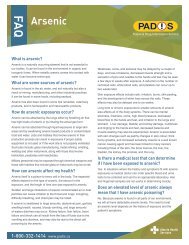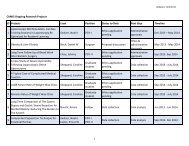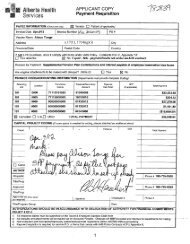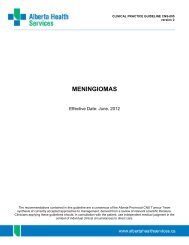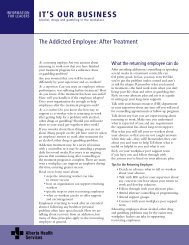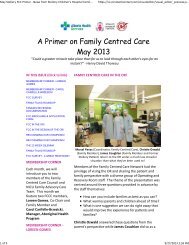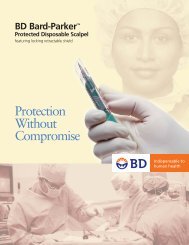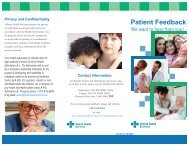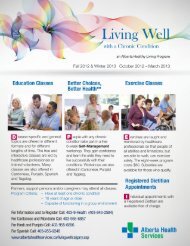Teaming Up for Tobacco-Free Kids: Teachers' Resource Kit ...
Teaming Up for Tobacco-Free Kids: Teachers' Resource Kit ...
Teaming Up for Tobacco-Free Kids: Teachers' Resource Kit ...
Create successful ePaper yourself
Turn your PDF publications into a flip-book with our unique Google optimized e-Paper software.
t e a m i n g u p f o r t o b a c c o - f r e e k i d s<br />
Section III Grade 5 Lesson 1<br />
THE RISKS AND CONSEQUENCES OF SMOKING<br />
Lesson Summary<br />
This lesson gives students a chance to describe the immediate and long-term effects<br />
of tobacco use.<br />
Health Curriculum Links<br />
General Outcome<br />
Students will make responsible and in<strong>for</strong>med choices to maintain health<br />
and to promote safety <strong>for</strong> themselves and others.<br />
Specific Outcomes<br />
L-5.3 Investigate the effectiveness of various decision-making strategies; e.g., decision<br />
by default, impulsive decision making, delayed decision making.<br />
R-5.3 Recognize that stressors affect individuals differently, and outline ways individuals<br />
respond to stress.<br />
R-5.4 Practice effective communication skills; e.g., active listening, perception checks.<br />
Preparation<br />
• Send letter home to parents<br />
• Read fact sheets<br />
Fact Sheet 2 – Your Body<br />
Fact Sheet 3 – What’s in It?<br />
Fact Sheet 4 – A Drug<br />
Fact Sheet 6 – Second-hand Smoke<br />
• Photocopy<br />
Student <strong>Resource</strong> 2 – Refusal Skills<br />
Student <strong>Resource</strong> 3 – Word Puzzle<br />
Transparency 1 – What Is a Drug?<br />
Transparency 2 – Drugs May Be Used <strong>for</strong> Different Reasons<br />
Transparency 3 – Smoking Facts<br />
Transparency 4 – What Is Dependency?<br />
Lesson Duration<br />
60 minutes<br />
15
t e a m i n g u p f o r t o b a c c o - f r e e k i d s<br />
Section III Grade 5 – Lesson 1<br />
Activities<br />
Truth or Dare – 50 minutes<br />
Divide students into groups of three or four. Distribute a copy of Student <strong>Resource</strong> 3<br />
(Word Puzzle) to each student. Explain that this exercise is designed to get students<br />
thinking about the risks of smoking. Allow students 20 to 30 minutes to create their<br />
word-find or crossword puzzles. Tell students they will use the ideas on the puzzles<br />
to play a game later. Then, ask students to write their opinions about why people<br />
continue to smoke despite the risks.<br />
To initiate discussion, ask the class to answer the following questions:<br />
From the word puzzle’s word list, what would most likely stop you from smoking?<br />
Do you think people enjoy their first smoking experience? Why? If not, why do they<br />
try it again?<br />
Do you know anyone trying to quit smoking?<br />
Why do you think it is difficult <strong>for</strong> them to quit?<br />
What would make it easier <strong>for</strong> you (support you) to avoid tobacco use?<br />
Are there any other influences that could make avoiding tobacco use difficult?<br />
Discuss with the class some situations that may make it difficult <strong>for</strong> them to avoid tobacco<br />
use. For example:<br />
· If your parents or older siblings smoke, you may want to share that activity.<br />
· You may have friends who want to try smoking.<br />
· You know older kids who smoke and they tell you they can quit if it becomes a problem.<br />
Explain that the first smoking experience is usually unpleasant. Possible consequences<br />
are nausea, dizziness, upset stomach and/or diarrhea. Explain the reasons why people<br />
may keep smoking.<br />
· To project an image – they may be attracted to symbols that they think show<br />
others they are grown up (e.g., cigarettes).<br />
· To receive social support – they may hang around with people who smoke and<br />
may be encouraged to try it again.<br />
· To seek acceptance – some kids need to feel they are part of a group (in this case,<br />
a group that smokes).<br />
Following the discussion<br />
Have each student in the group develop truth questions. The truth questions should<br />
test knowledge about risk and consequences related to tobacco use and link to the class<br />
discussion. Each group member will take a turn leading the game.<br />
16
t e a m i n g u p f o r t o b a c c o - f r e e k i d s<br />
Section III Grade 5 – Lesson 1<br />
The group leader will ask each student to select truth or dare. If a student chooses dare,<br />
all group members will act out a situation where one student dares another to smoke<br />
a cigarette. The student must think of a way to refuse the cigarette. If the student<br />
chooses truth, the group leader will ask one of their “truth” questions.<br />
Class discussion – 10 minutes<br />
Ask students to share their thoughts about the game. Probe with questions such as:<br />
What can you do to make sure you don’t start smoking?<br />
If you don’t want to smoke, how do you resist smoking when others pressure you to try it?<br />
Ask students to think of situations where they may be offered a cigarette. Hand out Student<br />
<strong>Resource</strong> 2 (Refusal Skills). Explain that it is helpful to plan their responses be<strong>for</strong>e they are<br />
in these situations. Have students complete the worksheet and suggest they practice their<br />
responses alone or with friends. Another strategy <strong>for</strong> saying no to smoking is to avoid these<br />
situations altogether by spending more time with non-smokers.<br />
Provide the following in<strong>for</strong>mation<br />
· 17.9% of Alberta teens (age 12 to 19) smoke.<br />
· Smoking is no longer considered the norm; almost 75% of Canadians do not smoke.<br />
As a final question, ask the students to do some math. Count how many students are in<br />
class. Then, have students calculate one-fifth (20%) of this number. Statistically, this is<br />
approximately how many of the students that may be smoking by the time they graduate<br />
high school. Ask the class if they feel this figure is accurate.<br />
Adapted from: Sense and Non-Sense: Healthy Choices About Alcohol, Drugs and Gambling - Grade 5. AADAC,<br />
1997. <strong>Tobacco</strong> Basics Handbook, AADAC, 2002.<br />
17
t e a m i n g u p f o r t o b a c c o - f r e e k i d s<br />
Section III Grade 5 Lesson 2<br />
THE POSITIVE EFFECTS OF BEING SMOKE-FREE<br />
Lesson Summary<br />
This lesson provides students an opportunity to learn about the health benefits<br />
of being a non-smoker.<br />
Health Curriculum Links<br />
General Outcome<br />
Students will make responsible and in<strong>for</strong>med choices to maintain health<br />
and to promote safety <strong>for</strong> themselves and others.<br />
Specific Outcomes<br />
W-5.6 Examine and evaluate the impact of caffeine, alcohol and drugs on personal<br />
health/wellness; e.g., physical, emotional, social.<br />
W-5.8 Promote safety practices in the school and community.<br />
Preparation<br />
• Send letter home to parents<br />
• Read fact sheets<br />
Fact Sheet 2 – <strong>Tobacco</strong> and Your Body<br />
Fact Sheet 5 – Spit <strong>Tobacco</strong><br />
• Photocopy<br />
Student <strong>Resource</strong> 4 – Math Puzzle<br />
Lesson Duration<br />
Materials<br />
55 minutes<br />
• Large chart paper<br />
• Coloured pens<br />
18
t e a m i n g u p f o r t o b a c c o - f r e e k i d s<br />
Section III Grade 5 – Lesson 2<br />
Activities<br />
Class brainstorming – 5 minutes<br />
Have students brainstorm the negative effects of smoking. List responses on the board<br />
or chart paper.<br />
Group webbing – 20 minutes<br />
Have students <strong>for</strong>m small groups of four or five. Give each group a piece of large chart<br />
paper and a coloured pen (no two colours alike per group). Ask a member of each group<br />
to write the words “smoke-free” in the middle of the paper. For 5-10 minutes, have<br />
the group brainstorm the positive aspects of being a non-smoker and living in a smoke-free<br />
environment. Ask students to write their ideas on the group paper and use lines to connect<br />
their words to the word “smoke-free”. Ask each group to share their webs with the class.<br />
Have students work together to identify key words, ideas and phrases from their lists and<br />
help them compile one master list on another large sheet of chart paper. Have students use<br />
the master list to choose their top five positive aspects of being smoke-free, and read them<br />
over the morning announcements <strong>for</strong> one week.<br />
Creating puzzles – 30 minutes<br />
Hand out Student <strong>Resource</strong> 4 (Math Puzzle). Have students <strong>for</strong>m groups or work individually<br />
to complete the activity. Discuss the statements on the math puzzle as a class.<br />
Adapted from: Sense and Non-Sense: Healthy Choices About Alcohol, Drugs and Gambling - Grade 5. AADAC,<br />
1997.<br />
19
t e a m i n g u p f o r t o b a c c o - f r e e k i d s<br />
Section III Grade 5 Lesson 3<br />
AT WHAT COST?<br />
Lesson Summary<br />
This lesson gives students a chance to calculate the financial costs of smoking.<br />
Health Curriculum Links<br />
Preparation<br />
General Outcome<br />
Students will use resources effectively to manage and explore life roles and career<br />
opportunities and challenges.<br />
Specific Outcome<br />
W-5.6 Examine and evaluate the impact of caffeine, alcohol and drugs on personal<br />
health/wellness; e.g., physical, emotional, social.<br />
L-5.6 Assess how roles, expectations and images of others may influence career/life role<br />
interests; e.g., influence of family, friends, role models, media.<br />
• Send letter home to parents<br />
• Photocopy<br />
Student <strong>Resource</strong> 5 – The Price of Using <strong>Tobacco</strong><br />
Lesson Duration<br />
Materials<br />
Activities<br />
35 minutes<br />
• Newspapers<br />
• Chart paper (optional)<br />
• Drawing paper<br />
Newspaper search – 10 minutes<br />
Have students <strong>for</strong>m groups of four. Provide each group with a newspaper. Ask students<br />
to look through the newspaper and choose two or three recreational items that they’d<br />
like to own (e.g., trail bike, computer game or skis).<br />
One group member will record items and prices on the board or chart paper. Ask students to<br />
discuss how they save money (or help their families save) <strong>for</strong> leisure and recreational activities.<br />
20
t e a m i n g u p f o r t o b a c c o - f r e e k i d s<br />
Section III Grade 5 – Lesson 3<br />
Pairs check – 15 minutes<br />
Provide each student with Student <strong>Resource</strong> 5 (The Price of Using <strong>Tobacco</strong>). Have students<br />
work with a partner to answer the questions. One partner completes the worksheet while<br />
the other acts as coach, helping if necessary. When the worksheet is completed, the coach<br />
must agree with the answers. If the partners cannot agree on the answer, they ask <strong>for</strong> your<br />
help. After students have completed the worksheet, review the answers. Discuss how<br />
the recreational items listed on the board cost less than G.R.’s smoking expenses.<br />
Pictographs – 10 minutes<br />
Using the expense totals from the worksheet, have students draw pictures of items<br />
they could purchase with the money saved in a week (compact disc), a month<br />
(a computer program) or a year (a trip <strong>for</strong> two to Disneyland). The pictographs<br />
can be displayed and viewed by the students.<br />
Adapted from: Sense and Non-Sense: Healthy Choices About Alcohol, Drugs and Gambling - Grade 5. AADAC, 1997.<br />
21



